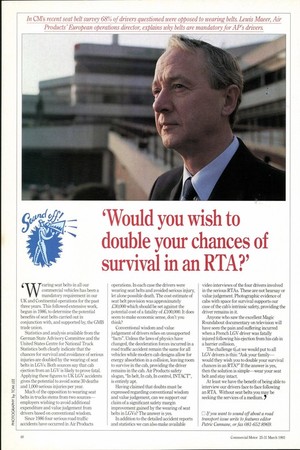'Would you wish to double your chances of survival in an RTA?'
Page 50

If you've noticed an error in this article please click here to report it so we can fix it.
(W earing seat belts in all our commercial vehicles has been a mandatory requirement in our UK and Continental operations for the past three years. This followed extensive work, begun in 1986, to determine the potential benefits of seat belts carried out in conjunction with, and supported by, the GMB trade union.
Statistics and analysis available from the German State Advisory Committee and the United States Centre for National Truck Statistics both clearly indicate that the chances for survival and avoidance of serious injuries are doubled by the wearing of seat belts in LGVs. Both sources say that cab ejection from an LGV is likely to prove fatal. Applying these figures to UK LGV accidents gives the potential to avoid some 30 deaths and 1,000 serious injuries per year.
Much of the opposition to wearing seat belts in trucks stems from two sources— employers wishing to avoid additional expenditure and value judgement from drivers based on conventional wisdom.
Since 1986 four serious road traffic accidents have occurred in Air Products operations. In each case the drivers were wearing seat belts and avoided serious injury, let alone possible death. The cost estimate of seat belt provision was approximately £30,000 which should be set against the potential cost of a fatality of £100,000. It does seem to make economic sense, don't you think?
Conventional wisdom and value judgement of drivers relies on unsupported "facts". Unless the laws of physics have changed, the deceleration forces incurred in a road traffic accident remain the same for all vehicles while modern cab designs allow for energy absorbtion in a collision, leaving room to survive in the cab, providing the driver remains in the cab. Air Products safety slogan, "In belt, In cab, In control, INTACT", is entirely apt.
Having claimed that doubts must be expressed regarding conventional wisdom and value judgement, can we support our claim of a significant safety margin improvement gained by the wearing of seat belts in LGVs? The answer is yes.
In addition to the detailed accident reports and statistics we can also make available video interviews of the four drivers involved in the serious RTAs. These are not hearsay or value judgement. Photographic evidence of cabs with space for survival supports our case of the cab's intrinsic safety, providing the driver remains in it.
Anyone who saw the excellent Magic Roundabout documentary on television will have seen the pain and suffering incurred when a French LGV driver was fatally injured following his ejection from his cab in a barrier collision..
The challenge that we would put to all WV drivers is this: "Ask your family— would they wish you to double your survival chances in an RTA?" If the answer is yes, then the solution is simple—wear your seat belt and stay intact.
At least we have the benefit of being able to interview our drivers face to face following an RTA. Without seat belts you may be seeking the services of a medium. / El If you want to sound off about a road transport issue write to features editor Patric Cunnane, or fax 081-652 8969.




















































































